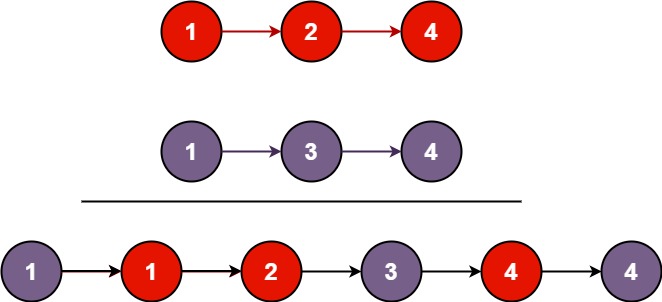2020-12-28 Daily-Challenge
Today I have done Merge Two Sorted Lists on leetcode and leetcode's December LeetCoding Challenge with cpp.
Merge Two Sorted Lists
Description
Merge two sorted linked lists and return it as a new sorted list. The new list should be made by splicing together the nodes of the first two lists.
Example 1:

Input: l1 = [1,2,4], l2 = [1,3,4]
Output: [1,1,2,3,4,4]
Example 2:
Input: l1 = [], l2 = []
Output: []
Example 3:
Input: l1 = [], l2 = [0]
Output: [0]
Constraints:
- The number of nodes in both lists is in the range
[0, 50]. -100 <= Node.val <= 100- Both
l1andl2are sorted in non-decreasing order.
Solution
nothing to say
class Solution {
public:
ListNode* mergeTwoLists(ListNode* l1, ListNode* l2) {
ListNode *newHead = new ListNode();
ListNode *cur = newHead;
while(l1 && l2) {
if(l1->val < l2->val) {
cur->next = l1;
l1 = l1->next;
} else {
cur->next = l2;
l2 = l2->next;
}
cur = cur->next;
}
if(l1) cur->next = l1;
if(l2) cur->next = l2;
return newHead->next;
}
};
December LeetCoding Challenge 28
Description
Reach a Number
You are standing at position 0 on an infinite number line. There is a goal at position target.
On each move, you can either go left or right. During the n-th move (starting from 1), you take n steps.
Return the minimum number of steps required to reach the destination.
Example 1:
Input: target = 3
Output: 2
Explanation:
On the first move we step from 0 to 1.
On the second step we step from 1 to 3.
Example 2:
Input: target = 2
Output: 3
Explanation:
On the first move we step from 0 to 1.
On the second move we step from 1 to -1.
On the third move we step from -1 to 2.
Note:
target will be a non-zero integer in the range [-10^9, 10^9].
Solution
we can just think that target is a positive integer, because we are on a infinite number line and we can go both directions at any time, so we can reach -n with same moves as n, just take every moves to opposite direction.
at first, I find that we can use two moves to step exactly 1. so I think I can find the moves n where n*(n+1)/2(farthest position by n moves), and find how many moves I need to achieve target.
which is wrong solution XD
because we can go back at any time, so optimal solution is go back at the right move. it's obviously that if we reverse one move, we will go back at a even number. which means simply reverse moves won't change parity of position by specified moves, so we may need to take at most two steps forward.
so here's our solution:
- find
nwherenis smallest positive number that $\frac{n*n(+1)}{2}\ge target$ - if $\frac{n*n(+1)}{2} = target$,
nis answer- if $\frac{nn(+1)}{2} > target$ and $\frac{nn(+1)}{2} - target$ is even,
nis still answer, we'll take a negative move when it comes to $\frac{\frac{n*n(+1)}{2} - target}{2}$th move - if $\frac{nn(+1)}{2} > target$ and $\frac{nn(+1)}{2} - target$ is odd:
- if
nis even, we take one more step forward, and take a negative move at $\frac{\frac{n*n(+1)}{2} - target + n+1}{2}$th move - if
nis odd, we take one more step forward, and take two negative move where their sum is $\frac{\frac{n*n(+1)}{2} - target + n+1+n+2}{2}$.
- if
- if $\frac{nn(+1)}{2} > target$ and $\frac{nn(+1)}{2} - target$ is even,
class Solution {
public:
int reachNumber(int target) {
target = abs(target);
int start = 1, end = 45555;
while(start < end) {
int mid = (start + end) / 2;
int pos = mid * (mid + 1) / 2;
if(pos < target) {
start = mid + 1;
} else {
end = mid;
}
}
int answer = start;
int diff = abs(target - start * (start + 1) / 2);
if(diff & 1) {
answer += 1 + ((start&1)^1);
}
return answer;
}
};